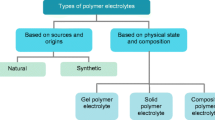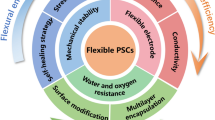Abstract
We examine the characteristics and functionality of conjugated polymer thin films, based on blends of poly(9,9-dioctylfluorene-2,7-diyl-co-bis-N,NN′-(4-butylphenyl)-bis-N,N′-phenyl-1,4-phenylenediamine) (PFB) and poly(9,9-dioctylfluorene-2,7-diyl-co-benzothiadiazole) (F8BT), using a spray-coating deposition technique suitable for large areas. The morphological properties of these blend films are studied in detail by atomic force microscopy (AFM) methods, showing that favourable results, in terms of layer deposition rate and uniformity, can be achieved using a 5:1 blend of o-dichlorobenzene and chlorobenzene as the solvent medium. A photoluminescence quenching efficiency of above 80 % is also observed in such blend films. As a feasibility study, prototypical photovoltaic devices exhibit open circuit voltages of up to 1.0 V under testing, and solar power conversion efficiencies in the 0.1–1 % order of magnitude; metrics which are comparable with those reported for spin-coated cells of the same active blend and device architecture.





Similar content being viewed by others
Notes
These materials were characterized as follows: F8BT; Mn = 81 k, Mp = 174 k, polydispersity (PD) = 2.6, photoluminescence quantum yield (PLQY) = 82 %. PFB; Mn = 39 k, Mp = 162 k, PD = 4.5, PLQY = 27 %.
References
Middleman S, Hochberg AK (1993) Process engineering analysis in semiconductor device fabrication. McGraw-Hill, New York
Kamtekar KT, Monkman AP, Bryce MR (2010) Recent advances in white organic light-emitting materials and devices. Adv Mater 22:572–582
Gelinck GH, Huitema HEA, van Veenendaal E et al (2004) Flexible active-matrix displays and shift registers based on solution-processed organic transistors. Nat Mater 3:106–110
Günes S, Neugebauer H, Sariciftci NS (2007) Conjugated polymer-based organic solar cells. Chem Rev 107:1324–1338
Bouclé J, Ravirajan P, Nelson J (2007) Hybrid polymer–metal oxide thin films for photovoltaic applications. J Mater Chem 17:3141–3153
Thompson BC, Fréchet JMJ (2008) Organic photovoltaics: polymer-fullerene composite solar cells. Angew Chem Intl Ed 47:58–77
Chen H-Y, Hou J, Zhang S et al (2009) Polymer solar cells with enhanced open-circuit voltage and efficiency. Nat Photonics 3:649–653
Jørgensen M, Norrman K, Krebs FC (2008) Stability/degradation of polymer solar cells. Sol Energy Mater Sol Cells 92:686–714
Krebs FC (2009) Fabrication and processing of polymer solar cells: a review of printing and coating techniques. Sol Energy Mater Sol Cells 93:394–412
Susanna G, Salamandra L, Brown TM, Di Carlo A, Brunetti F, Reale A (2011) Airbrush spray-coating of polymer bulk-heterojunction solar cells. Sol Energy Mater Sol Cells 95:1775–1778
Abdellah A, Fabel B, Lugli P, Scarpa G (2010) Spray deposition of organic semiconducting thin-films: towards the fabrication of arbitrary shaped organic electronic devices. Org Electron 11:1031–1038
Girotto C, Rand BP, Genoe J, Heremans P (2009) Exploring spray coating as a deposition technique for the fabrication of solution-processed solar cells. Sol Energy Mater Sol Cells 93:454–458
Hoth CN, Steim R, Schilinsky P, Choulis SA, Tedde SF, Hayden O, Brabec CJ (2009) Topographical and morphological aspects of spray coated organic photovoltaics. Org Electron 10:587–593
McNeill CR, Greenham NC (2009) Conjugated-polymer blends for optoelectronics. Adv Mater 21:3840–3850
Green R, Morfa A, Ferguson AJ, Kopidakis N, Rumbles G, Shaheen SE (2008) Performance of bulk heterojunction photovoltaic devices prepared by airbrush spray deposition. Appl Phys Lett 92:033301
Shikler R, Friend RH (2007) Modeling the effect of the structure of polymer photocells on their absorption spectrum. J Appl Phys 102:013105
Mueller R, Kleinebuddel P (2007) Comparison of a laboratory and a production coating spray gun with respect to scale-up. AAPS Pharm Sci Tech 8(1):E1–E11
Kietzke T (2007) Recent advances in organic solar cells. Adv Optoelectron. Article ID 40285
Hallam T, Lee M, Zhao N, Nandhakumar I, Kemerink M, Heeney M, McCulloch I, Sirringhaus H (2009) Local charge trapping in conjugated polymers resolved by scanning kelvin probe microscopy. Phys Rev Lett 103:256803
Mullen K, Scherf U (2006) Organic light-emitting devices. Wiley, New York
Finlayson CE, Whitney AD (2010) Photophysical studies of poly-isocyanopeptide based photovoltaic blends. J Phys D 43:095501
McNeill CR, Westenhoff S, Groves C, Friend RH, Greenham NC (2007) Influence of nanoscale phase separation on the charge generation dynamics and photovoltaic performance of conjugated polymer blends: balancing charge generation and separation. J Phys Chem C 111:19153–19160
Moulé AJ, Bonekamp JB, Meerholz K (2006) The effect of active layer thickness and composition on the performance of bulk-heterojunction solar cells. J Appl Phys 100:094503
Commission Internationale de l’Eclairage (CIE) Proceedings of 1931 (1932). Cambridge University Press, Cambridge
Menke SM, Pandey R, Holmes RJ (2012) Tandem organic photodetectors with tunable, broadband response. Appl Phys Lett 101:223301
Kawano K, Pacios P, Poplavskyy D, Nelson J, Bradley DDC, Durrant JR (2006) Degradation of organic solar cells due to air exposure. Sol Energy Mater Sol Cells 90:3520–3530
Liang YY, Xu Z, Xia J, Tsai S-T, Wu Y, Li G, Ray C, Yu L (2010) For the bright future-bulk heterojunction polymer solar cells with power conversion efficiency of 7.4%. Adv Mater 22:E135–E138
Yuan Y, Huang J, Li G (2011) Intermediate layers in tandem organic solar cells. Green 1:65–80
Lange A, Wegener M, Fischer B, Janietz S, Wedel A (2012) Solar cells with inkjet printed polymer layers. Energy Procedia 31:150–158
Hoth CN, Schilinsky P, Choulis SA, Brabec CJ (2008) Printing highly efficient organic solar cells. Nano Lett 8:2806–2813
Søndergaard RR, Hösel M, Krebs FC (2012) Roll-to-roll fabrication of large area functional organic materials. J Polym Sci B 51:16–34
Søndergaard RR, Hösel M, Angmo D, Larsen-Olsen TT, Krebs FC (2012) Roll-to-roll fabrication of polymer solar cells. Mater Today 15:36–49
Frederik C, Krebs FC, Espinosa N, Hösel M, Søndergaard RR, Jørgensen M (2014) Rise to power—OPV-based solar parks. Adv Mater 26:29–39
Jaworek A (2007) Electrospray droplet sources for thin film deposition. J Mater Sci 42:266–297. doi:10.1007/s10853-006-0842-9
Muhammad NM, Sundharam S, Dang H-W, Lee A, Ryu B-H, Choi K-H (2011) CIS layer deposition through electrospray process for solar cell fabrication. Curr Appl Phys 11:S68–S75
Sun Y, Welch GC, Leong W-L, Takacs CJ, Bazan GC, Heeger AJ (2012) Solution-processed small-molecule solar cells with 6.7% efficiency. Nat Mater 11:44–48
Tang ML, Reichardt AD, Nobuyuki M, Stoltenberg RM, Bao Z (2008) Ambipolar, high performance, acene-based organic thin film transistors. J Am Chem Soc 130:6064–6065
Wang T, Scarratt NW, Yi H et al (2013) Fabricating high performance, donor–acceptor copolymer solar cells by spray-coating in air. Adv Energy Mater 3:512–515
Acknowledgements
The authors thank Mr Matt Gunn of Aberystwyth University for advice and technical assistance. The authors acknowledge Cambridge Display Technology (CDT Ltd) for the supply of materials used in this work, and Scanwel Ltd for technical support with AFM measurements. This work was supported by a Royal Society (UK) Research Grant (RG110313).
Author information
Authors and Affiliations
Corresponding author
Rights and permissions
About this article
Cite this article
Noebels, M., Cross, R.E., Evans, D.A. et al. Characterization of spray-coating methods for conjugated polymer blend thin films. J Mater Sci 49, 4279–4287 (2014). https://doi.org/10.1007/s10853-014-8123-5
Received:
Accepted:
Published:
Issue Date:
DOI: https://doi.org/10.1007/s10853-014-8123-5




